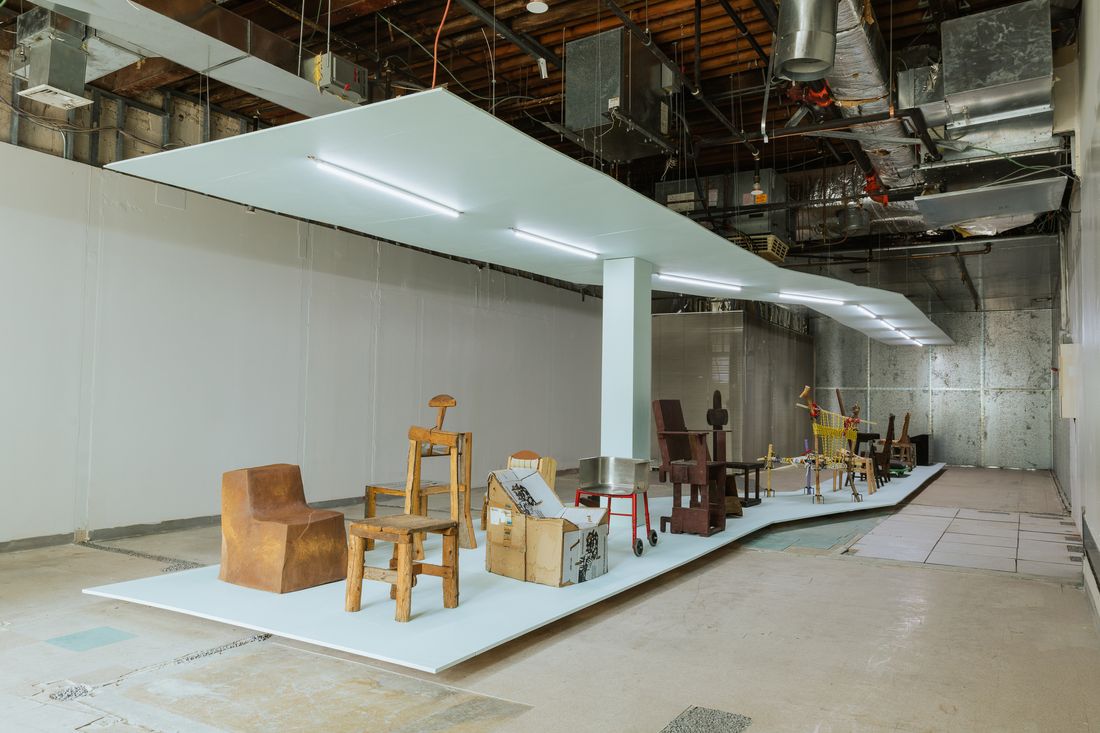
“Make-do,” an exhibition of ad hoc chairs, features contemporary and antique seats.
Photo: Jason Le, Courtesy Marta
At the foot of the Bowery, there’s a strange-looking postmodernist building with an arched metal door framed by slender columns and capped with a mint-green pediment. It’s been vacant for the past ten years, and the last tenant seems to have ripped out whatever they could, leaving behind only cracked linoleum floors, uneven tile, and galvanized-metal walls — traces of the building’s past lives as a bank, a nightclub, and, most recently, a medical center. Until May 27, it’s the site of “Make-do,” a pop-up exhibition of 24 antique and contemporary chairs organized by Benjamin Critton and Heidi Korsavong, founders of the Los Angeles–based gallery Marta, and Avi Kovacevich, a co-founder of the auction house Catalog Sale. Like the architecture that surrounds it, the furniture in the show is also patched together: chairs made from eyewash stations, safety cones, car-seat covers, tree branches, an old quilt that would probably turn to dust if you actually sat down on it. Most are lined up on a jagged powder-blue platform that cuts through the center of the room, part of an exhibition design by Cat Snodgrass of Bi-Rite Studio that mostly leaves the half-demolished space as it is.
The exhibit, which coincides with New York’s Design Week, is meant to be an homage to the improvisational instincts needed to survive in the city. (As Critton says, “You really have to fucking ‘make do’ in this town!”) But it’s also a fun window into how inventive artists can be with what’s at hand. For the 12 designers in the show, Critton and Korsavong did away with the constraints that often bog down designers — from their own perfectionism to the demands of clients — by asking them to create chairs with just one limitation: time. They only had three days to find materials, design a chair, and build it. These new pieces are loosely paired with 12 antique chairs from the personal collection of Kovacevich, who started collecting makeshift furniture after seeing a photo essay on the cobbled-together chairs frequently spotted on the streets of China.
A foam chair by Wentrcek Zebulon; an anonymously made chair from the 1890s with a quilt draped over it; Sebastijan Jemec and Georgia McGovern’s car-seat cover chair; Miles Huston’s rolling seat composed of a Womb chair cushion, plywood, and takeout containers; and a wood-crate chair from the 1940s.
Photo: Jason Le, Courtesy Marta
The result is an exhibition of unexpected forms made with familiar DNA. Most of the contemporary pieces were composed of materials and objects the artists already had lying around in their studios: Old Jewelry founder Sarah Burns built a low-slung wood chair using offcuts from her new furniture collection (which is on view at Marta right now); Shaina Tabak took scrap aluminum from a mirror she made for the Bushwick nightclub Rash (which closed due to arson last year) and fastened it to a reclaimed-wood frame; and Sebastijan Jemec (who recently designed guerilla seating on Canal Street for a Storefront for Art and Architecture exhibition) and his partner Georgia McGovern used scrap wood and a beaded-wood car seat cover for their contribution to the show. Some artists ventured further out of their comfort zones. Samuel Brockman, who normally works with wood, welded together a metal sink and the bottom half of a walker he found on a road trip to make his chair for the show. But are the designs truly “ad hoc”? Some of the recent pieces appear to be a bit more polished compared to the historic chairs, which have been repaired and added to over time and are well worn with dirt and use. Other works aren’t that different from what the designers normally make, like Wentrcek Zebulon’s foam-and-fiberglass armchair.
Part of the thrill of the exhibit is noticing how the artists approached the same problem in similar ways, regardless of what era they worked in. For example, a rope-entwined twig chair by Chen Chen & Kai Williams shows hints of an 1890s stool with a dug-out wood seat and a web of leather draped over the top. Their piece also shares the spindly, askew look of another 1890s chair Kovacevich found in Bucks County, Pennsylvania, made entirely of branches. In another pairing, Isabel Rower and an anonymous artist both used taped-up cardboard to design their chairs, but Rower used it to build a mold for her stoneware piece instead of for the finished product. Remarkably, they’re both about the same size and shape.
“Make-do” is on view at 5 Chatham Square through May 27.
Chen Chen & Kai Williams, Pineal Lobotomy, 2023, made from wood, repurposed steel, and ropes.
Anonymous (found in Bucks County, P.A.), Untitled Twig Chair, c. 1890s, made from branches and paint.
ShainaTabak, Untitled, 2023, made from old-growth timber and aluminum.
Anonymous (found in Berkshire County, M.A.), Untitled Chair w/ Headrest, c. 1930s, made from wood, wire, rags, and hardware.
Sebastijan Jemec and Georgia McGovern, Alphabet City (ABCD) Chair, 2023, made from scrap wood, powder-coated screws and hooks, and a beaded car-seat cover.
Anonymous (found in Lincoln County, M.E.), Untitled Sling Chair, c. 1940s, made from wood, paint, carpet, and hardware.
Isabel Rower, Box Chair, 2023, made from stoneware.
Anonymous (found in Kings County, N.Y.), Untitled Cardboard Chair, c. 2010s, made from cardboard and poly tape.
Photos: Courtesy Avi Kovacevich

